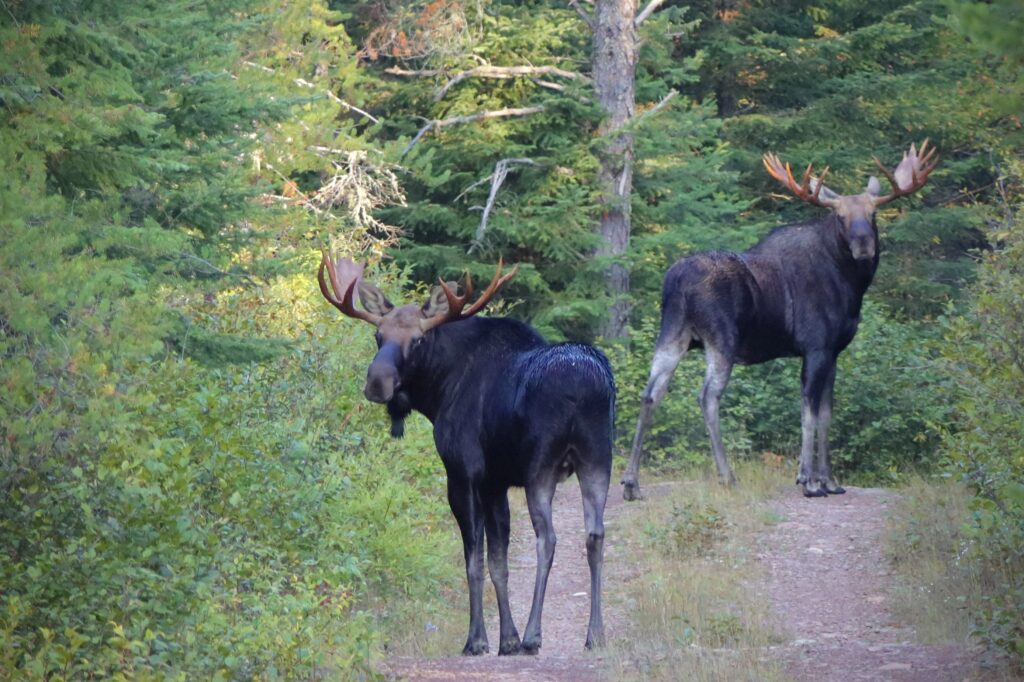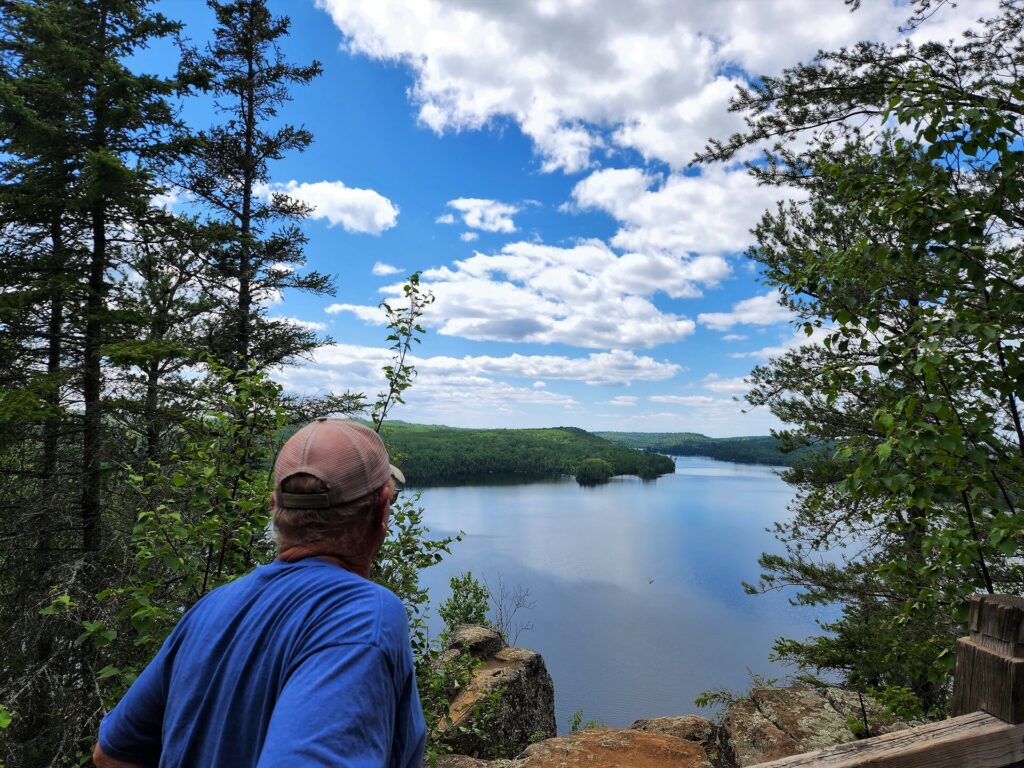Wildlife populations follow up-and-down cycles for many species living in the Northern Wilds. Ruffed grouse are a famous example (this year’s MN DNR spring ruffed grouse population count is the highest since 1972). Snowshoe hare are another cyclical species, and to this day scientists debate what causes their cycles to rise and fall. Many species are also dependent on fluctuations in the populations of their prey. We are left to observe in awe how nature takes its course.
Yet what about those changes introduced by humankind? What would our Lake Superior fisheries be like today if non-native species like coho salmon or steelhead trout were never stocked in the lake? Are our Northern Wilds really so wild if humans can create vast population changes in local species through our actions alone? Let’s take a look at three species (a mammal, insect, and fish) to see how human-induced change has impacted—and continues to impact—life in our northern woods.
Demise of the Woodland Caribou
One monumental change that happened in an incredibly short timespan in the Northern Wilds was the demise of the woodland caribou. Prior to European settlement, this area included vast white pine, red pine, and jack pine tracts—home to the woodland caribou. The caribou ate lichens that grew beneath the towering pine canopies and on areas of exposed bedrock—wherever understory shrub and forb cover was sparse or very patchy. Then, at the end of the 19th century, humans came in with their saws to turn the stately pines into lumber for a growing nation. As deforestation and widespread, large catastrophic fires rolled over the Arrowhead, habitat for lichens and the woodland caribou was radically changed and diminished, and no longer capable of supporting a woodland caribou population.
Chel Anderson, Hovland resident and author of North Shore: A Natural History of Minnesota’s Superior Coast (published in 2015 by University of Minnesota Press), emphasizes that ground-living lichens are typically most abundant where light is more available under sparser cover of shrubs and herbaceous plants. These conditions are more common in woodland, exposed bedrock and raised bog native plant communities, than in forest plant communities. “Woodlands are very different from forests,” Anderson explains. “Often occurring on thinner, drier, more fire-prone soils, they typically have a more open understory than forests do. This understory fosters the growth of lichens, that woodland caribou use as a food source, particularly in wintertime. In more recent times, land management practices, suppression of natural fire disturbance regimes and land conversion have contributed to diminishing habitat with appropriate conditions and extent to support a population of woodland caribou throughout much of their former range.”
Mankind’s clear-cutting of the north woods starting 130 years ago during the lumber craze effectively ostracized woodland caribou from northern Minnesota and the surrounding Canadian regions. But besides habitat loss, unregulated human hunting pressure also hastened the disappearance of woodland caribou from the area—another layer of human induced change. One of the last known woodland caribou herds survived in the large, very remote peatland complex at the headwaters of the St. Louis River. In the 1891 Public Land Survey General Description for T59N R11W, the surveyor wrote: “Great numbers of Caribou (American Reindeer/Woodland Caribou) live in these swamps… If these animals are to be preserved, a fork of 10 sq. miles should be fenced and guarded as they are fast disappearing before the Winchester rifles of the hunters.” No such reserve was ever created.

The final blow to the caribou’s original territory came from other large mammals. Jean Cochrane, a conservation biologist who worked with the U.S. Fish and Wildlife Service, says that caribou proved to be less adaptable than other ungulates. “Caribou couldn’t compete with what came after the logging—dense browse favored moose and newly-arrived deer, which thrive in young forests.” Thus, the habitat change created by humans favored other species to the detriment of less adaptable caribou.
The last caribou was seen on Isle Royale in 1928, and the last regular sightings in northeast Minnesota came in the 1940s. Long-time residents of the Grand Marais area may remember one exception to the disappearance of caribou. Cochrane recounts the event: “The last recorded caribou stragglers sighted in Cook County came down from Ontario to near Hovland in the winter of 1981-1982.”
Today, your best chance to observe woodland caribou in the wild may be on Canada’s Slate Islands, in Lake Superior, with an estimated population of 45. Some of these caribou were actually moved to the Slates by the Ontario Ministry of Natural Resources and Forestry in 2018 from Michipicoten Island, where wolves were threatening to decimate the island’s herd.
Wood Ticks Get a Ride to the Northern Wilds
Ask area old-timers if they remember seeing wood ticks as kids, and you’ll hear the same reply again and again: there were no ticks here in the past. “When I moved here 50 years ago, it was a nearly impossible task to get a wood tick on you,” recalls Anderson. “When I was young, nobody got ticks,” concurs Buck Benson, another long-time resident of the North Shore.
So, what happened? Anderson believes the spread of people, especially those with livestock or pets, and wildlife moving in from places where wood ticks were common, were mainly responsible for the introduction of ticks to the area. “The only place I could ever find ticks in my early years here was at the site of an old logging camp on the Cook County-Lake County line,” says Anderson.
“Movements and land use of people and animals carrying ticks began introducing wood (and other) ticks to new places,” Anderson continues. “The ticks’ spread was successful, as wood ticks dropped off of a draft horse, farm animal, dog, or wildlife species that it used as a host.” Those individual points of tick colonization have gradually expanded into a widespread population. “We now know that it doesn’t take long for ticks to spread across the landscape,” says Anderson.
Besides wood ticks, deer ticks (that carry Lyme disease), and winter ticks (that suck the blood and nutrients out of moose), are also at play in the north woods today. Anderson notes that a “synergy” of factors—such as winter ticks combined with a warming climate—have caused increased stress on moose survival. The winter ticks—quarter-sized when engorged—can cover a moose in the tens of thousands. While winter ticks may have existed naturally in the Northern Wilds in the past, their effects on moose are being exacerbated by longer warmer periods of the year. Despite their name, winter ticks can’t survive cold winters if they don’t have a host, like moose. Late falls give winter tick nymphs extra time to find a host, and early springs give females abundant leaf litter to lay their eggs in, leading to increased winter tick abundance. Little ticks, small as they are, and the diseases they may carry, are one of the most concerning changes in local wildlife patterns.
Survival of Coldwater Fish
The Minnesota state fish is the walleye. Also called “pickerel” in Canada, the walleye is categorized as a coolwater fish. The walleye’s range covers the entire state of Minnesota, and all of southern Ontario. But what about coldwater species, including lake trout, lake whitefish, and cisco—that have traditionally thrived in the cold, deep inland lakes of the Arrowhead, as well as in Lake Superior? Are they still thriving today? There are 855 total lakes in Minnesota documented to contain coldwater species, and many of them are currently under threat.
Aaron Sundmark and Derek Bahr are both lake IBI (“index of biological integrity”) biologists with the MN DNR. They are part of a team of researchers, together with the Minnesota Pollution Control Agency, developing water quality standards to protect coldwater lake habitats in Minnesota. This research involves measuring water temperatures and oxygen levels throughout the water column at the height of summer in Minnesota’s deepest, coldest lakes. Currently, Sundmark is taking teams of data collectors by canoe to the Boundary Waters to measure what’s happening with water temperature stratification and dissolved oxygen in lakes that are potential refuges for coldwater species.
According to Bahr, “Whitefish, cisco, and lake trout are all good indicator species, which means that they are sensitive to, and respond predictably to various stressors that are occurring on the landscape. Because of their importance, and the recognition that they are sensitive to different stressors, the DNR is monitoring these populations, and observing trends through time.”
The DNR’s efforts have unfortunately revealed a decline in mean cisco catch per standard gill net in Minnesota inland lakes since the sampling protocol was standardized in 1993. Because of that decline, the DNR is making an increased effort to understand the actual threats to cisco and other coldwater species. These include cultural eutrophication (excess nutrients), climate change (warming lake temperatures), and aquatic invasive species.
August is the hardest month for coldwater fish, as lakes undergo the “summer squeeze”—the period of maximum oxythermal stress. At this time, the deepest parts of lakes do not hold enough oxygen for fish to breathe (caused by eutrophication), while water temps closer to the surface are too warm for coldwater fish to survive. These fish thereby get squeezed into a narrow vice of liveable habitat partway down the water column. As the vice tightens, fish can struggle to find suitable habitat from lack of oxygen.
Enter the “coldwater standards.” The DNR and MPCA have identified nutrient and oxythermal benchmarks (coldwater standards) that lakes should attain to continue supporting coldwater species. The DNR is aiming to prioritize protection of lakes of biological significance, protecting and maintaining them from shoreline development to give them the best chance of avoiding eutrophication and maintaining their oxythermal habitat.
The DNR’s research on water quality and temperature in coldwater lakes suggests that “many cisco or lake whitefish lakes currently do not have protective enough standards to properly support coldwater fish habitat.” And the DNR is doing something about it. Setting water quality standards will help the DNR to regulate activity in the landscape around coldwater lakes, thereby keeping water clean and cold for sensitive fish species.
Overall, human intervention in the landscape has greatly affected the populations of caribou, ticks, and coldwater fish in our region. In fact, one could argue that not a single wildlife species has gone unchanged by the influence of humankind since European settlement in the area. The caribou are gone, the ticks are here, and the survival of whitefish, cisco, and lake trout in our region will depend greatly on human protection of cold water as time goes on. While nature has always been changing, not only because of human intervention, it’s our duty to learn from the mistakes of our past, and to weigh the importance of our actions on local wildlife populations today.

